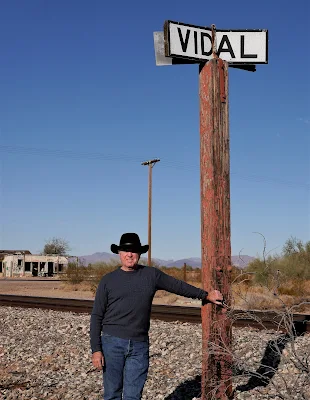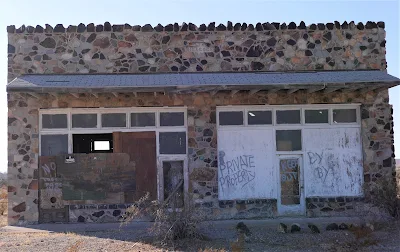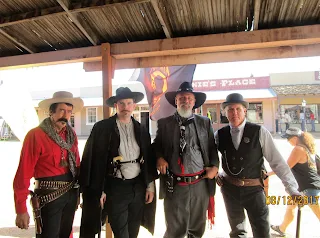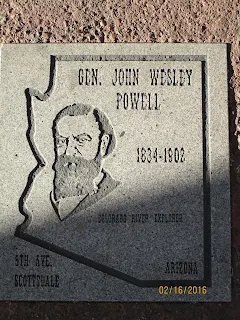.JPG) |
| John R Beyer at Vidal Junction, California |
As I have in written in past articles, there are places we are destined to travel to without even meaning to travel there.
If I haven’t written that, I should have, sounds almost brilliant. One of those memorable quotes.
Anyway, when we travel, there are times we are moving toward a final destination, but sometimes on the way to that objective, another stopping-place shows up in front of us that is just as intriguing.
That is truly adventure.
As a travel writer, I find myself in that realm quite often, and I find it reassuring. Just because I want to end up at one place, doesn’t mean I don’t want to find myself in a totally different locale. That is what makes life so exciting.
Okay, enough philosophy – on with what this article is about.
Growing up in Southern California, I spent a lot of time at the Colorado River. The main route I used was Interstate 10, to Blythe and then north on Highway 95 to the Parker Strip. A friend of mine, Bob, had a place along the river, and we’d spend countless hours boating on that stretch of water and then relaxing after a tiring, but fun filled day with our families.
Good times.
Well, during those trips, I must have driven past Vidal dozens of time, and never gave it a second thought.
A bent sign, along Highway 95, letting the passerby know there may have been something worthwhile there once, but apparently that something was long ago. Slow down, take the railroad tracks carefully at Vidal, especially if towing anything, and then drive on to Parker.
That was the extent of my knowledge of Vidal.
On a recent trip, Laureen and I, again were buzzing south on Highway 95 and passed that bent sign indicating the town of Vidal.
“Wonder what’s there?” Laureen asked.
“Nothing, would be my guess,” I replied.
“Let’s check it out. You never know,” she said.
And we did. I made a legal U-turn and headed back to that tall crooked sign. Getting out of our vehicle, we snapped a few photographs and started walking east on the dirt road, known as the Old Parker Road – not to be confused with the New Parker Road.
.JPG) |
| Laureen Beyer at the end to the tracks in Vidal Junction, California |
Train tracks ran right next to the roadway. They were empty, straight, as if they hadn’t been used in a long time - lonely. I doubted that, since trains seemed to run through this part of the country all the time. None did while we were there, but that didn’t mean they didn’t use these tracks – just not for the thirty minutes we wandered here and there.
“That’s a nice looking little house,” Laureen mentioned, as she pointed to a very well-kept white and blue cottage.
She was correct. The house stood out in the brown desert like an unforgotten jewel. Perhaps a ruby, that has been neglected by a heart broken lover – what?
Man, this is starting to sound like a cheap dime novel.
Turns out, that the nice looking little house was the only permanent abode for Wyatt Earp and his wife, Josephine – who went by Sadie.
.JPG) |
| John R Beyer in front of the Earp's house, Vidal Junction, California |
Yes, probably one of the most famous western lawmen – among other things, who rode a horse through the southwest.
The Wyatt Earp, who became even more famous, or infamous, after that thirty second street battle at the OK Corral in Tombstone, Arizona. Two factions of westerners had had enough with one another, and temperatures boiled over in the afternoon of October 26th, 1881. In a matter of a half a minute, three were dead and three wounded. Tombstone would soon become a household word.
The violence would also go down as the most famous gunfight in the American Wild West. Sorry, Wild Bill Hickok.
There is a cement slab with a plaque, in front of the small house, explaining – ‘The legendary lawman, gun-fighter, gambler, businessman, and miner along with his wife Josephine inhabited this “Dream-Come-True” cottage from 1925 – 1928. During the fall, winter and spring months while he worked his “Happy Days” mines in the Whipple Mountains a few miles north of this site. This is the only permanent residence they owned in their long lives together.’
Long life together, meant forty-seven years. They married – common-law – in 1882, and stayed with each other until Wyatt’s death on January 13, 1929.
That is a long time in anyone’s book, especially for a guy who had been mixed up in more gunplay then I’ve had IRS audits. Did I just write that?
It should be noted, that during Wyatt’s life, he moved around a lot – gambling here and there, looking for minerals in the mountains of Arizona and California, sitting for interviews, and the like. The Earp’s never really settled down, but instead rented hotels and small homes during their married life.
It wasn’t until they purchased the small cottage in Vidal in 1925 that they had true roots. They’d summer in Los Angeles and the rest of the year mainly in Vidal.
An interesting point, that the Earp’s were actually living in Calzona – not far from Vidal – in 1922, when a huge fire destroyed the town, but miraculously the little house didn’t burn.
The house was moved to Vidal, where the Earp’s eventually bought it.
According to a couple of sources online, Morgan Earp (Wyatt’s younger brother) was the original owner of the house in Calzona, but he was murdered in 1882 in Tombstone – revenge killing for the OK Corral gunfight, and I couldn’t find material backing up those suggestions.
The way with history, one person writes this and the other person writes that. It is romantic, in a literary way though, to believe Wyatt and Sadie actually lived in the house that Wyatt’s younger brother had built.
Let’s allow that bit of history go without much further investigation.
So, now that we knew this little burg had a lot more going for it, we decided to explore a bit more.
Over on Main Street, all these towns have a main street, stands a beautiful rock and mortar two story building. On the top, like castles of old, are jagged rocks as though they expected Vikings to storm the building.
.JPG) |
| Original store in Vidal Junction, California |
No Vikings, and really not much on the history of the building. It must have cost a pretty penny – or a lot of pretty pennies – to build such a place.
In a statement on the website, flickeriver.com, the building had various businesses which occupied the building through the years. A barbershop, an assayers office – make sense if Wyatt and others were mining for gold – and other commercial endeavors. There were supposed showers behind the building for cowboys to rinse off the dust of the desert.
In full disclosure, the research on this building did not yield much information. Actually, very little about both Vidal and the surrounding area is very limited online. That is a shame, since this was once the home of an iconic member of the ‘old west’ legend.
.JPG) |
| Mainly ruins in Vidal Junction |
As mentioned earlier, Wyatt and Sadie resided in Vidal during the fall, winter, and spring times, moving back to Los Angeles during the summer. A little bit warm in Vidal during that scorching time of year. Besides, Wyatt did work as a consultant for some film companies assisting in making western movies as accurate as possible.
As mentioned in truewestmagazin.com, the early cowboy star, Tom Mix, and Wyatt became very close friends, so close that Mix served as a pallbearer at Earp’s funeral.
Rumor has it, Tom Mix cried.
According to justwestofmyheart.blogspot.com, the town of Vidal kept growing with ranchers, miners, traders, and the building of the Los Angeles Aqueduct in the 1930’s. ‘By 1935, the area had no less than 28 liquor establishments, the paper describing them as “hangouts for river toughs and equally tough women.”
But, the great depression played havoc everywhere, and one place hit especially hard was Vidal. Soon people left and the desert began to encroach back on the emptiness left behind by the vanishing citizens.
.JPG) |
| A relatively newer structure in Vidal Junction, California |
Not much is left to Vidal today. A few deserted houses, Wyatt’s cottage, the remains of the JM Heacock building, and a cemetery across the railroad tracks.
Is it worth a stop along Highway 95? Yes, it is.
“I bet this place has a very intriguing past, I bet,” Laureen stated, as we headed to our vehicle.
“And I’d take that bet,” I replied. I knew that would be a sure wager.
.JPG)




































